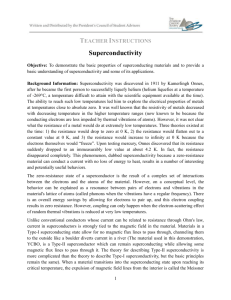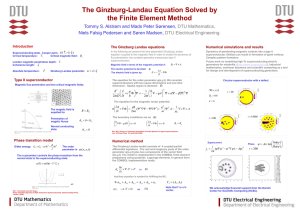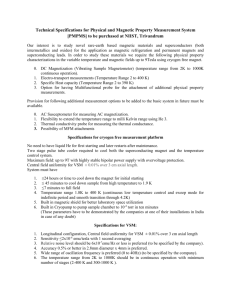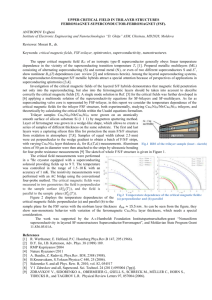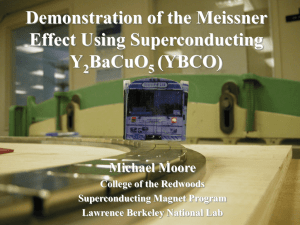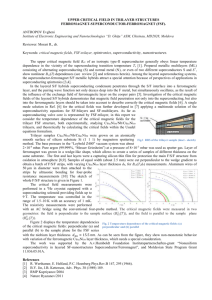Teacher Instructions Superconductivity
advertisement
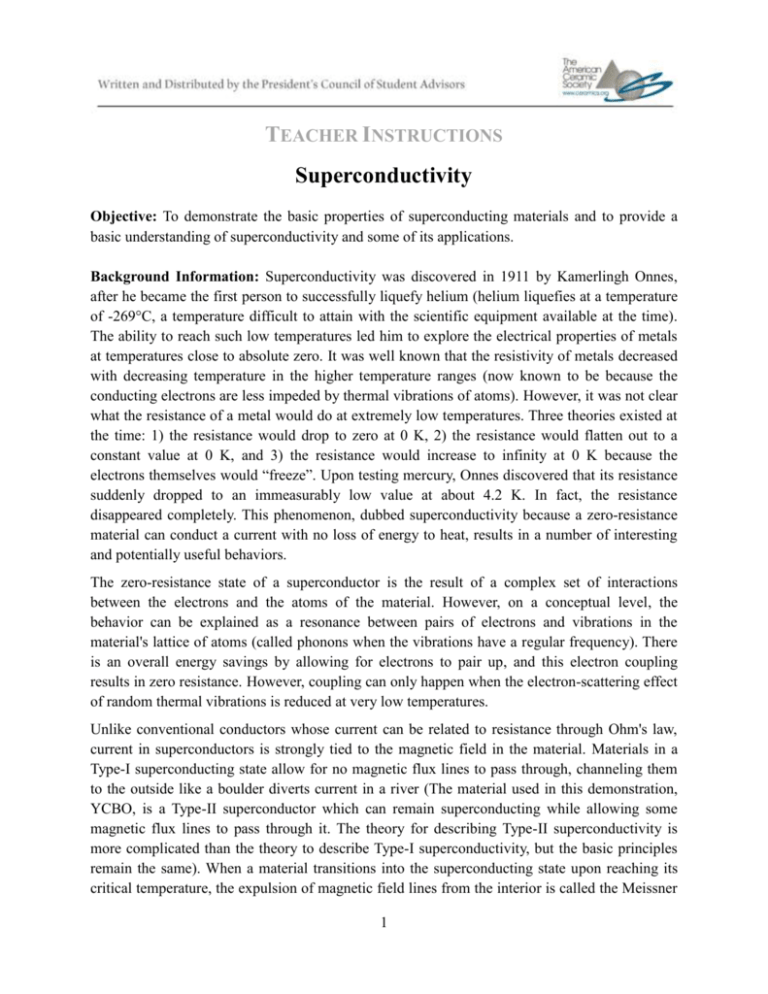
TEACHER INSTRUCTIONS Superconductivity Objective: To demonstrate the basic properties of superconducting materials and to provide a basic understanding of superconductivity and some of its applications. Background Information: Superconductivity was discovered in 1911 by Kamerlingh Onnes, after he became the first person to successfully liquefy helium (helium liquefies at a temperature of -269°C, a temperature difficult to attain with the scientific equipment available at the time). The ability to reach such low temperatures led him to explore the electrical properties of metals at temperatures close to absolute zero. It was well known that the resistivity of metals decreased with decreasing temperature in the higher temperature ranges (now known to be because the conducting electrons are less impeded by thermal vibrations of atoms). However, it was not clear what the resistance of a metal would do at extremely low temperatures. Three theories existed at the time: 1) the resistance would drop to zero at 0 K, 2) the resistance would flatten out to a constant value at 0 K, and 3) the resistance would increase to infinity at 0 K because the electrons themselves would “freeze”. Upon testing mercury, Onnes discovered that its resistance suddenly dropped to an immeasurably low value at about 4.2 K. In fact, the resistance disappeared completely. This phenomenon, dubbed superconductivity because a zero-resistance material can conduct a current with no loss of energy to heat, results in a number of interesting and potentially useful behaviors. The zero-resistance state of a superconductor is the result of a complex set of interactions between the electrons and the atoms of the material. However, on a conceptual level, the behavior can be explained as a resonance between pairs of electrons and vibrations in the material's lattice of atoms (called phonons when the vibrations have a regular frequency). There is an overall energy savings by allowing for electrons to pair up, and this electron coupling results in zero resistance. However, coupling can only happen when the electron-scattering effect of random thermal vibrations is reduced at very low temperatures. Unlike conventional conductors whose current can be related to resistance through Ohm's law, current in superconductors is strongly tied to the magnetic field in the material. Materials in a Type-I superconducting state allow for no magnetic flux lines to pass through, channeling them to the outside like a boulder diverts current in a river (The material used in this demonstration, YCBO, is a Type-II superconductor which can remain superconducting while allowing some magnetic flux lines to pass through it. The theory for describing Type-II superconductivity is more complicated than the theory to describe Type-I superconductivity, but the basic principles remain the same). When a material transitions into the superconducting state upon reaching its critical temperature, the expulsion of magnetic field lines from the interior is called the Meissner 1 effect. According to Maxwell's theory of electromagnetism, a complex arrangement of currents on the surface of the material, called screening currents, produces a magnetic field exactly equal and opposite to the external field. The resulting magnetic forces are often strong enough to exceed the force of gravity, allowing for the magnetic levitation which is highlighted in this demonstration. Applications for superconductors are varied and take advantage of their different properties. The ability to produce magnetic levitation is used in Maglev trains to create frictionless bearings, which allow for very high speeds and a perfectly smooth ride. Coils of superconducting wire can produce large magnetic fields with relatively low power input. These super electromagnets are used in MRI medical instruments, among other places. Two other applications with huge potential are those of using superconductors to replace conventional power transmission lines and to create magnetic fields to contain the plasma developed in nuclear fusion reactors. The former application needs further research to be attractive for large-scale production due to the brittleness of most superconductor materials (making it difficult to draw them into wires), as well as the cost of refrigerating long expanses of transmission lines. If fusion reactor technology is to become a reality, the latter application will be a crucial component of successfully implementing this technology. Description: A pellet of superconducting yttrium barium copper oxide (YBCO) will be submerged in liquid nitrogen and cooled below its critical temperature of 93 K (-180.2°C/292.3°F). A permanent magnet will then be placed above the superconductor pellet, and the interaction between the two pieces' magnetic fields will allow the magnet to levitate. Keywords: Electric current: flow of electric charge Electric field: a vector field which describes the electric influence of electrically charged particles or a time-varying magnetic field Magnetic field: a vector field which describes the magnetic influence of an electric current or magnetic material Flux: flow of a quantity (material, field, etc.) through a unit area Critical temperature: temperature at which a superconducting material loses its resistance and exhibits superconducting behavior Phonon: arrangement of atoms which have a regular vibration frequency Meissner effect: expulsion of magnetic fields from a superconductor as it transitions to its superconducting state Materials List: YBCO pellet Liquid nitrogen 2 Small permanent magnet Petri dish (or a foam coffee cup bottom) Tongs (must be plastic) Insulating gloves Safety glasses Safety Precautions: Liquid nitrogen is a hazardous substance. If misused, it may cause frostbite, eye damage, torn flesh, or asphyxiation. ALWAYS FOLLOW THESE SAFETY RULES: Keep liquid nitrogen away from students. Wear safety goggles at all times. Use tweezers to handle superconductors, magnets, or other small, cold objects. Plastic tweezers are desired but should be tested for embrittlement (see last caution) before use in the classroom. Wear insulating gloves when handling liquid nitrogen containers or large, cold objects. Use liquid nitrogen only in well ventilated places. Do not allow liquid nitrogen to touch any part of your body. Items in contact with liquid nitrogen become EXTREMELY COLD. Do not touch any item that has been immersed in liquid nitrogen until it has warmed to room temperature. Do not store liquid nitrogen in any container with a tight-fitting lid. A tightly sealed container will build up pressure as the liquid boils and may EXPLODE after a short time. Many substances become brittle and may shatter when cold, sending pieces of the material flying. Avoid common glass and large, solid plastics. Instructions: 1. While wearing gloves, pour some liquid nitrogen into the petri dish. 2. Place the YBCO pellet in the liquid nitrogen and wait for it to reach its critical temperature, at which point it becomes superconducting (about a minute). 3. Move the permanent magnet to a short distance from the surface of the liquid nitrogen and directly above the YBCO. Release the magnet. When done properly, the magnet will levitate above the superconductor. If the magnet falls, use tongs to remove it from the liquid nitrogen and try again. 4. While keeping the magnet above the superconductor, move it to new positions and orientations. Spin the magnet in any position or orientation and observe it remain in that state. 5. If needed, add more liquid nitrogen to keep the YBCO below its critical temperature. 3 Demo Delivery Hints: Encourage students to safely approach the demo so they can see the superconducting behavior up close. For larger classes, have students approach in groups. Alternatively, if a video magnifier is available, the instructor may find it easiest to perform the demonstration under the camera and project the enlarged video feed on a screen. Troubleshooting: Ensure that the YBCO has cooled to below its critical temperature, otherwise superconducting behavior will not be observed. The critical temperature of YBCO is 93 K (180.2°C/-292.3°F), meaning that dry ice with a sublimation temperature of 194.7 K (-78.5 °C/109.3 °F) is insufficiently cold to induce superconductivity in YBCO. Of readily available coolants, only liquid nitrogen will be cold enough. Cleanup/Replacement parts: Remove the YBCO from the liquid nitrogen using tongs and allow it to warm to room temperature. Dispose of the liquid nitrogen by either letting it boil away completely, or for a bit more excitement, pour it carefully onto the floor where the liquid will form small spheres that will scatter and dissipate quickly. The YBCO and the permanent magnet can be reused indefinitely; to repeat the demonstration, obtain more liquid nitrogen. YBCO is a brittle ceramic. Dropping it on a hard surface, or dropping a magnet too large to levitate onto it may cause it to crack or shatter. In addition, prolonged exposure to moisture increases the susceptibility of YCBO to cracking; be sure to dry the pellet after it has warmed to room temperature to prevent water from condensing on its surface from the air. Storing the YBCO with desiccant is ideal. DISCLAIMER: ACerS’ President’s Council of Student Advisors (PCSA) provides these lesson documents in an editable Word format so that teachers may adapt the documents for their classroom needs. The PCSA encourages teachers to download and modify these documents as needed for their own classroom and to provide these documents to other teachers who are interested. As a result, you may not be reading an original version of the document. Original versions of the document may be downloaded from www.ceramics.org/pcsasciencekits . This disclaimer should be present in every version of the document that is shared among teachers. 4 TEACHER DISCUSSION QUESTIONS Superconductivity Discussion Questions to Ask Before the Demo 1. Take a moment to consider the question: how cold is 93 K, the critical temperature of YCBO? Discussion: Kelvin is a temperature scale that can be related to Celsius through the equation: K = C+273.15. Or to Fahrenheit using: K = (F+459.67)*(5/9). That means 93 K is -292°F! Zero Kelvin is called “absolute zero” and is the temperature at which the thermal motion of atoms stops. Try as we might, we cannot reach this temperature (the Third Law of Thermodynamics). Also, since 0 is placed at the bottom of the Kelvin scale, there are no negative temperatures. See Figure 1 for a comparison of the three most common temperature scales. Figure 1. A visualization of how the three main temperature scales compare 2. How do normal magnets interact with one another? Discussion: Permanent magnets (such as those found on your fridge) each have a north and a south pole, connected by magnetic field lines. When two magnets are brought close to one another, the north and south poles of the two magnets will attract, while the northnorth or south-south poles will repel. These repel because the field lines are pointing in opposite directions. They attract when the field lines are pointing in the same direction. 5 3. How does an electromagnet work? Discussion: An electromagnet is formed by coiling a wire and then running a current through it. The electric current flowing through the wire creates a magnetic field around the wire. Thus, when the current is turned off, the wire is no longer a magnet. These are often used in generators and motors and can also be found in your computer hard drive (it is the part that writes data to the hard drive). Discussion Questions to Ask During the Demo 1. What is the liquid nitrogen doing to the YBCO? Discussion: The liquid nitrogen boils at 77.2K, so the liquid nitrogen we see is just below this temperature. Since heat passes from hot to cold, heat is leaving the YBCO and entering the LN2. This is cooling the YBCO down to such a low temperature that the atoms themselves are moving less, and this allows the superconducting nature of the material. 2. Why is the permanent magnet floating above the YBCO? Discussion: The permanent magnet is being repelled by the YBCO. The YBCO is so cold that it allows for no magnetic flux lines to pass through it; therefore, the magnetic lines of the permanent magnet are not allowed to interact with it, creating a repulsive force. The repulsion is actually stronger than gravity (one could calculate the force of gravity operating on the permanent magnet). Discussion Questions to Ask After the Demo 1. What applications can you think of for superconductors? Discussion: See the Background Information section in the Teacher Instructions for discussion of this question. 2. Why is it so much more difficult to get one permanent magnet to levitate over another, without using a superconductor? Discussion: These permanent magnets do not necessarily have exactly equal and opposite magnetic fields due to varying size, shape, and even the magnet's microstructure. Also, the magnets would have to be precisely positioned, centering their magnetic fields. Since the superconductor is not a magnet by itself, all of its magnetic field comes from the zeroloss current induced on the surface by the permanent magnet. Wherever the magnet is 6 placed (if not over the edges), the superconductor will exactly balance the field of the magnet. 3. Can a superconductor carry an infinite current? Why or why not? Discussion: No, all superconductors have both a critical (magnetic) field and critical current density, which if exceeded, overloads the superconductor’s capacity to remain superconducting. The superconducting behavior will subsequently break down. 4. Can a superconductor repel an infinitely strong magnetic field? Why or why not? Discussion: No, for the reason stated in the Question 3 discussion. 5. Each new superconductor material has a critical temperature. YBCO is an important material because it has a critical temperature of 93K, which means that liquid nitrogen can cool it below its transition temperature. The newest materials are superconducting at temperatures as high as 138K. What would be the next important critical temperature(s) to reach, so that the material could be cooled more cheaply? Discussion: The next important temperature would be 195K, where dry ice could be used (although the solid would not extract heat as efficiently as a liquid). Next, liquid water could be used above 273K, and obviously through room temperatures (~300K). Finding a room-temperature superconductor would drastically reduce the world's energy consumption by eliminating power transmission losses (this accomplishment would be a guaranteed Nobel Prize). 6. YBCO at room temperature has a resistance to the flow of current. So what causes YBCO to exhibit zero resistance at low temperatures? Hint: Electric current is the flow of electrons. Something is different about the flow of electrons in the superconducting state in that they pass unobstructed by the lattice. Because they bump into nothing and create no friction, they can transmit electricity with no loss in the current and no loss of energy. Discussion: The understanding of superconductivity was advanced in 1957 by three American physicists – John Bardeen, Leon Cooper, and John Schrieffer, through their Theories of Superconductivity, known as the BCS Theory. Key points of BCS theory are (THE SCIENCE): The BCS theory successfully shows that electrons can be coupled to one another through interactions with the crystalline lattice of a material. This occurs despite the fact that electrons have the same charge. 7 When the atoms of a material oscillate in conjunction with the motion of the electrons, the electron pairs are able to move without being scattered. The electron pairing is favorable because it has the effect of putting the material into a lower energy state. When electrons are linked together in pairs, they move through the superconductor in an orderly fashion. At low temperatures, imagine each pair of electrons as a surfer catching a wave, except that the wave is in the material rather than in the ocean. If waves in the material have a regular frequency (making them phonons) like ocean waves, the electrons can surf through the material with no problem. This is similar to the YBCO at low temperature. At higher temperatures, the analogy is not so great, but imagine if the wind was always changing direction on the ocean. You might get sets of waves traveling in different directions, interacting with each other in crazy ways. The electron surfer would have a much harder time traveling smoothly in one direction. This is like the YBCO at room temperature. DISCLAIMER: ACerS’ President’s Council of Student Advisors (PCSA) provides these lesson documents in an editable Word format so that teachers may adapt the documents for their classroom needs. The PCSA encourages teachers to download and modify these documents as needed for their own classroom and to provide these documents to other teachers who are interested. As a result, you may not be reading an original version of the document. Original versions of the document may be downloaded from www.ceramics.org/pcsasciencekits . This disclaimer should be present in every version of the document that is shared among teachers. 8 STUDENT QUESTION HANDOUT Superconductivity 1. What magnetic phenomenon occurs within a superconductor when it is cooled below its critical temperature? 2. Why does a superconductor need to be kept at low temperatures to maintain superconducting properties? 3. How does a superconductor levitate permanent magnets? 4. How is this levitation different than that caused by the interaction between two permanent magnets or a conventional electromagnet? 5. Why do metals, such as copper and gold (which are some of the best conventional conductors), not become superconductors? Hint: think about the energy savings associated with electron coupling in superconducting materials vs. non-superconducting materials. 6. Can a superconductor carry an infinite current? Why or why not? 7. Can a superconductor repel an infinitely strong magnetic field? Why or why not? 9
